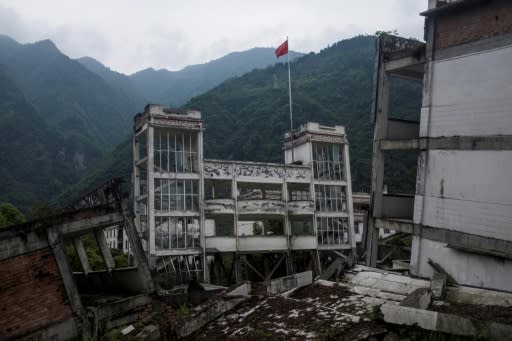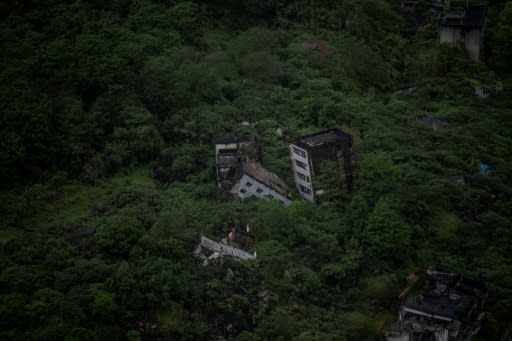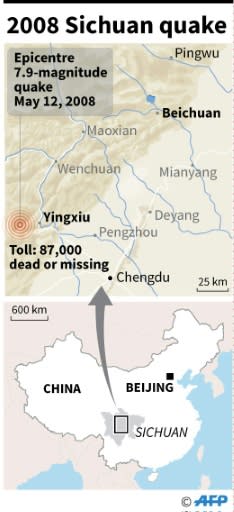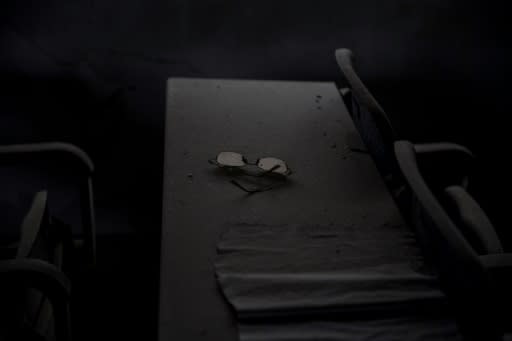China quake survivors relive trauma for tourists in city ruins
For almost a decade, Chen Guoxing has devoted himself to preserving a city of ghostly ruins in southwest China, a massive open air memorial to tens of thousands killed in a devastating earthquake -- including his son. The 54-year-old government official is in charge of maintaining the broken buildings of Beichuan, a small city that has been frozen in time since May 12, 2008, when the 7.9-magnitude earthquake left 87,000 people dead or missing across Sichuan province. As China prepares for Saturday's 10-year anniversary of the disaster, Chen's team of around 200 carry out the physically and emotionally draining work of preserving the wreckage, in which an estimated 20,000 bodies may be entombed. Twenty guides relive their trauma for over 2.2 million tourists a year, shepherding them down the eerily quiet streets and through the rubble of their lives. Many more work to protect the remaining structures and piles of debris from the assault of time and the elements, hoping to preserve the ruins as a reminder of life's fleeting nature. - 'The sky had fallen' - Along Beichuan's streets, buildings lean at weird angles, many held up by metal girders and struts. Tourists, walking down the buckled asphalt, stop to peer into piles of rubble and through windows into the chaos of abandoned apartments, pointing out an infant's knitted slipper, the weathered skin of a basketball. Visitors are barred from entering the structures because of safety concerns. But Chen led AFP reporters into a former teacher's dormitory, where a thick layer of dust covered hundreds of books spread in mouldering piles on the floor. The building was a time capsule: many of the residents died in the disaster, Chen said, and family members had largely decided not to reclaim their possessions. A mass grave on the city's east side is home to 3,000 dead. There were too many bodies, and not enough time, to give each a proper burial. Based on census figures, officials estimate another 20,000 people remain entombed in the ruins: Chen's son -- who died when his middle school collapsed -- is among them. Most were lost among the mud slides and deeply piled rubble. Rescuers feared disinterring the remains would spread disease. Tourists and family members burn incense to honour the dead. Chen was working in a nearby village when the earthquake struck. He was trapped. "We had no communication with the outside world," he said, as he surveyed Beichuan's ruins. More than 10 days later, he heard on the radio that his son had died. "It was like the sky had fallen," he said. One hundred days after the quake, he caught a ride back to Beichuan on a military helicopter. He had lost eight relatives. "I never saw my son's body," he said. "There was no time... our main responsibility was the rescue work." - A new city - Since the earthquake, tourism has become the region's largest industry, Chen said, with restaurants and hotels cashing in on the daily caravans of tour buses. Visitors tour the ruins -- there are no fees for entrance or guides -- and a nearby memorial hall, before heading to new Beichuan, a bustling city of wide avenues and abundant green space built from the ground up, 30 kilometres away. Chen, along with many of Beichuan's original residents moved there in the years after the earthquake, purchasing homes in neat apartment complexes built with government assistance. The city and its residents are largely dependent on tourism dollars, although speciality crops, such as cherries, have become an important business. Some locals complain that visitor numbers have declined in recent years, fretting about how they will survive in 10 or 20 years, when interest in the disaster inevitably wanes. Standing in the nearby town of Yingxiu in front of a sculpture of a giant clock showing the earthquake's time and date, a 25-year-old guide, surnamed Ma, expressed concern about the region's future. She and her coworkers spend their days standing on the highway, vying to flag down tourists on the way to the site. She would prefer not to be a guide but her family could not afford to send her to high school and this was the best job she could find. "We can't just rely on tourism to support ourselves," she said, as she showed visitors the ruins of her former middle school -- a memorial to the dead, including her former classmates. - What's important - In addition to the emotional challenges, Beichuan's preservation efforts have faced financial and technical obstacles. The project is the largest of its kind, Chen said, and the city spends over 20 million yuan ($3.1 million) a year on its upkeep. "The main difficulty we're facing is a financial problem," he said, adding that rain, wind and corrosion could eventually lead to the complete collapse of many of the site's buildings. Despite the difficulties, visitors' reactions make the effort all worthwhile, tour guide Wang Huarong, 33, said. "Once they've seen the ruins of the old city, their thinking changes," she said. "They realise the things that they thought were especially important before aren't that important." "As long as you can be together with your family, that's happiness." The ruins of Xuankou Middle School still stand, 10 years after a huge quake that levelled swathes of Sichuan province, killing tens of thousands of people Nature is gradually reclaiming the homes that were destroyed by the 2008 quake, despite efforts to preserve Beichuan as a living monument to those who were killed Map showing the region of the 2008 Sichuan quake in China. Around 20,000 bodies are thought to be entombed in the mud and rubble left behind by the 2008 earthquake A thick layer of dust cakes the abandoned classroom that stands as a monument to those who lost their lives in the 2008 earthquake Guides shepherd tourists around the ruins of their destroyed town in the hope of explaining the tragedy of a natural disaster that left tens of thousands of people dead Abandoned everyday items bear powerful testimony to the lives extinguished by the powerful 2008 quake








